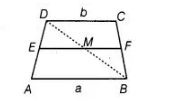ABCD is a trapezium with parallel sides AB = a cm and DC = b cm. E and F are the mid-points of the non-parallel sides. The ratio of ar
(ABFE) and ar (EFCD)is
(a) a: b
(b) (3a + b): (a + 3b)
(c) (a + 3b): (3a + b)
(d) (2a +b): (3a + b)
(b) Given, $A B=a \mathrm{~cm}, D C=b \mathrm{~cm}$ and $A B \| D C$.
Also, $E$ and $F$ are mid-points of $A D$ and $B C$, respectively.
So, distance between $C D, E F$ and $A B, E F$ will be same say $h$.
Join $B D$ which intersect $E F$ at $M$.

Now, in $\triangle A B D, E$ is the mid-point of $A D$ and $E M \| A B$
So, $M$ is the mid-point of $B D$
and $\quad E M=\frac{1}{2} A B \quad$ [by mid-point theorem] ...(i)
Similarly in $\triangle C B D$, $M F=\frac{1}{2} C D$ .....(ii)
On adding, Eqs. (i) and (ii), we get
$E M+M F=\frac{1}{2} A B+\frac{1}{2} C D$
$\Rightarrow$ $E F=\frac{1}{2}(A B+C D)=\frac{1}{2}(a+b)$
Now, area of trapezium $A B F E=\frac{1}{2}$ (sum of parallel sides)
$\times$ (distance between parallel sides)
$=\frac{1}{2}\left(a+\frac{1}{2}(a+b)\right) \times h=\frac{1}{4}(3 a+b) h$
Now, area of trapezium $E F C D=\frac{1}{2}\left[b+\frac{1}{2}(a+b)\right] \times h=\frac{1}{4}(3 b+a) h$
$\therefore$ Required ratio $=\frac{\text { Area of } A B F E}{\text { Area of } E F C D}=\frac{\frac{1}{4}(3 a+b) h}{\frac{1}{4}(3 b+a) h}$
$=\frac{(3 a+b)}{(a+3 b)}$ or $(3 a+b):(a+3 b)$
